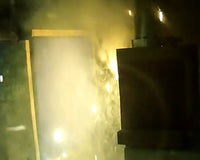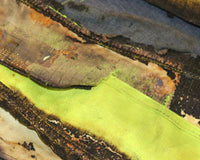EN ISO 11611 outlines the European safety standards for protective clothing worn by welders, ensuring they are protected from heat, flames, molten metal, and related hazards that occur during welding and allied processes. This safety standard provides the minimal requirements and test methods to keep the wearer safe while they work.
The EN ISO 11611 standard
EN ISO 11611 is a European standard that outlines the minimum basic safety requirements and test methods for protective clothing used in welding and allied processes. This safety standard is designed to protect the wearer from hazards that occur during welding and allied processes, such as droplets of molten metal, short contact with flame, and radiant heat from arc.
EN ISO 11611 sets the requirements for materials, design, performance, and labelling of welding protective clothing to ensure the safety of workers in these environments. Clothing certified to this standard can be categorised into two classes, allowing the worker to choose the most appropriate level of protection based on their environment.
Then EN ISO 11611 safety standard was brought into effect in 2002, replacing the previous EN 470-1 standard for protective clothing for welding and allied processes. EN ISO 11611, however, superseded EN 470-1 due to being a more thorough standard that incorporates advancements in materials and testing methods.
The types of protective clothing covered under EN ISO 11611 includes hoods, aprons, sleeves, and gaiters designed to protect the worker’s body including head and feet, and worn during welding and allied processes. For the protection of the wearer's head and feet, this standard is only applicable to hoods and gaiters. EN ISO 11611 does not cover requirements for feet, hands, face, and/or eye protectors.
EN ISO 11611:2015
EN ISO 11611:2015 is the latest update of this safety standard, replacing the previous version of EN ISO 11611:2007.
While EN ISO 11611:2015 is currently the most updated version of this safety standard, it is currently under review and is due to be replaced by ISO/FDIS 11611. Once the updated ISO/FDIS 11611 standard has been developed, EN ISO 11611:2015 will be withdrawn.
EN ISO 11611 requirements and test methods
EN ISO 11611 outlines the requirements and test methods for protective clothing designed to protect the wearer against welding and similar allied processes. The requirements determined by EN ISO 11611 cover the materials, design, performance, and labelling specifications.
EN ISO 11611 outlines 13 specific design requirements for certified protective clothing. The design must, for example, reduce the risk of the garment accumulating welding spatter. As a result, EN ISO 11611 clothing will feature fewer or no pockets than other protective clothing to minimise build up of spatter or sparks.
The test methods conducted under EN ISO 11611 are:
- ISO 6942
- ISO 9150
- ISO 15025
- EN 1149-2
ISO 6942 test method
This test method assesses the material and material combinations exposed to radiant heat. In this test, a material sample is exposed to radiant heat (infrared rays). The temperature on the reverse (unexposed) side of the sample is registered using a calorimeter. Subsequently, the length of time the sample can remain exposed before its temperature rises by 24°C is measured.
This test is also used for EN 531C and has two different classes as follows:
- Class 1: Temperature increase occurs after ≥ 7 seconds
- Class 2: Temperature increase occurs after ≥ 16 seconds
ISO 9150 test method
This test method determines the behaviour of the material when exposed to small spatters of molten metal. The number of droplets it takes to cause an increase in temperature of 40°C on the reverse side of the sample is determined. This test also has two classes as follows:
- Class 1: Tested using ≥ 15 droplets of molten metal
- Class 2: Tested using ≥ 25 droplets of molten metal
ISO 15025 test method
This test method is used to measure limited flame spread. The test consists of applying a flame to a fabric sample for 10 seconds. To pass the test, the after flame & smoulder times and formation of holes must be within the tolerances (set in the standard). The application of a flame can take place in two ways:
- In procedure A (leads to Class A1): The flame is applied horizontally
- In procedure B (leads to Class A2): The flame is applied laterally
EN 1149-2 test method
This test method assesses the electrical resistance of a material sample to determine whether an electrical charge passes through the sample from the outside to the inside.
While EN ISO 11611 tests the electrical resistance of the protective clothing as per EN 1149-2, it is not designed to offer protection against electric shock nor does it offer protection from direct contact with arc welding installations carrying welding voltage. EN ISO 11611 protective clothing is designed to offer protection against short-term, accidental contact with live electric conductors with voltages up to approximately 100V DC.
EN ISO 11611 classes
EN ISO 11611 categorises certified clothing into two classes with specific performance requirements. The class level is determined by how well the clothing performs during the EN ISO 11611 test methods.
|
Class 1 (lower level) |
Class 2 (higher level) |
|
Designed to offer protection against less hazardous welding situations and techniques which produce the lowest levels of spatter and radiant. |
Designed to offer protection against more hazardous welding situations and techniques which produce the highest levels of spatter and radiant. |
If the sample material tested passes all the tests, it is categorised as Class 1, and if the material receives a Class 2 rating for the ISO 6942 and ISO 9150 tests, it is designated as Class 2. It is important to choose protective clothing of the correct class for your expected work environment.
Information on UV radiation hazards
Although Class 2 garments are designed to be more resistant than Class 1 garments, the resistance cannot be precisely quantified. Therefore, users exposed to UV radiation must be made aware of the risks and the protective clothing will require regular checks.
One way to check whether this garment still offers protection against UV radiation is to hold the garment up to the light of a 100W tungsten bulb at arm’s length (approximately 2m away from the bulb). If any light can be seen through the fabric, UV will be able to penetrate it too.
Similarly, if the wearer experiences any sunburn-like symptoms, this may be a sign that UVB is penetrating the clothing. In either case, the protective clothing should be replaced, and the use of additional, more resistant protective layers should be considered.


































